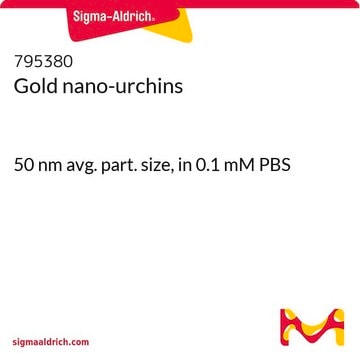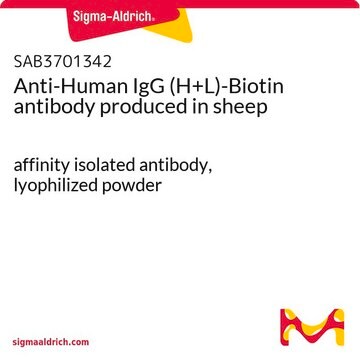The gold nanoparticles are capped with citrate.
753645
Gold nanoparticles
50 nm diameter, OD 1, stabilized suspension in 0.1 mM PBS, reactant free
Synonym(s):
Au NP, Gold colloid
About This Item
Recommended Products
Quality Level
form
nanoparticles
suspension
packaging
poly bottle of 100 mL
poly bottle of 25 mL
storage condition
do not freeze
concentration
~3.5E+10 particles/mL
OD
1
diameter
50 nm
λmax
531-535 nm
PDI
<0.2
storage temp.
2-8°C
SMILES string
[Au]
InChI
1S/Au
InChI key
PCHJSUWPFVWCPO-UHFFFAOYSA-N
Looking for similar products? Visit Product Comparison Guide
General description
Application
Legal Information
Storage Class Code
12 - Non Combustible Liquids
WGK
nwg
Flash Point(F)
Not applicable
Flash Point(C)
Not applicable
Choose from one of the most recent versions:
Already Own This Product?
Find documentation for the products that you have recently purchased in the Document Library.
Customers Also Viewed
Articles
Steven J. Oldenburg, Ph.D. provides an overview of lateral flow diagnostic assays and discusses the use of ultra-bright reporter particles based on the unique optical properties of gold nanoshells that significantly increase the sensitivity of lateral flow immunoassays.
Steven J. Oldenburg, Ph.D. provides an overview of lateral flow diagnostic assays and discusses the use of ultra-bright reporter particles based on the unique optical properties of gold nanoshells that significantly increase the sensitivity of lateral flow immunoassays.
Sustainable energy sources with high production efficiency are crucial for meeting increasing energy demand.
Steven J. Oldenburg, Ph.D. provides an overview of lateral flow diagnostic assays and discusses the use of ultra-bright reporter particles based on the unique optical properties of gold nanoshells that significantly increase the sensitivity of lateral flow immunoassays.
-
Are the nanoparticles capped with any agents? If so, please let me know the material used as the capping agent.
1 answer-
Helpful?
-
-
How many grams of gold nanoparticles in the 1 ml of 50nm gold nanoparticle suspension. Kindly provide this details as i need to know the diffusion rate of it.
1 answer-
This is a product of CytoDiagnostics, Inc. The 50 nm gold particles have a weight concentration of 44.5 ug/mL. This is an approximation as there is some degree of variability in particle size. See the image below to review the gold nanoparticle specification ranges.
Helpful?
-
-
Why does my gold nanoparticle solution turn violet when I add salt containing buffer?
1 answer-
Due to repulsive forces arising from the surface charge of gold nanoparticles, an energy barrier must be overcome for individual particles to interact. When no (or small) amounts of electrolytes such as NaCl is present, this energy barrier is too strong for interaction to occur between particles. However, upon addition of NaCl this energy barrier is reduced allowing the gold nanoparticles to interact and aggregate. This aggregation causes a phenomenon called surface-plasmon coupling which changes the adsorption maximum of light to a higher wavelength resulting in a change in color of the solution.
Helpful?
-
-
How do you attach gold nanoparticles to oligos?
1 answer-
To attach gold nanoparticles to oligos please view the information in the attached reference - Bioconjug Chem. 2011 Apr 20;22(4):794-807. Epub 2011 Mar 28.
Helpful?
-
-
What is the shape of the gold nanoparticles?
1 answer-
The majority (>95%) of the gold nanoparticles are spherical.
Helpful?
-
-
How do you attach gold nanoparticles to glass?
1 answer-
To view the procedure on how to attach gold nanoparticles to glass please view information in the reference - Journal of Atomic, Molecular, and Optical PhysicsVolume 2012 (2012). Article ID 683830, 6 pagesdoi:10.1155/2012/683830
Helpful?
-
-
How does the storage temperature relate to shipping conditions?
1 answer-
The storage conditions that a Sigma-Aldrich catalog and label recommend for products are deliberately conservative. For many products, long-term storage at low temperatures will increase the time during which they are expected to remain in specification and therefore are labeled accordingly. Where short-term storage, shipping time frame, or exposure to conditions other than those recommended for long-term storage will not affect product quality, Sigma-Aldrich will ship at ambient temperature. The products sensitive to short-term exposure to conditions other than their recommended long-term storage are shipped on wet or dry ice. Ambient temperature shipping helps to control shipping costs for our customers. At any time, our customers can request wet- or dry-ice shipment, but the special handling is at customer expense if our product history indicates that the product is stable for regular shipment.
Helpful?
-
-
Do I need to wash my gold nanoparticles?
1 answer-
For most applications, our gold nanoparticles can be used without any additional washing steps. If you have a sensitive application that requires additional washing the best way to do so is by either centrifugation or filtration.
Helpful?
-
-
What is the Department of Transportation shipping information for this product?
1 answer-
Transportation information can be found in Section 14 of the product's (M)SDS.To access the shipping information for this material, use the link on the product detail page for the product.
Helpful?
-
-
How do you attach gold nanoparticles to peptides and peptide conjugates?
1 answer-
To view information on how to attach gold nanoparticles to peptides and peptide conjugates, please view the information in the reference - Rosenthal, S. J. and Wright, D. W. (Eds.). (2005), p. 91-92. NanoBiotechnology Protocols. New Jersey. Humana Press.
Helpful?
-
Active Filters
Our team of scientists has experience in all areas of research including Life Science, Material Science, Chemical Synthesis, Chromatography, Analytical and many others.
Contact Technical Service



